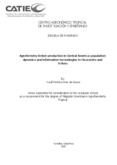Mostrar el registro sencillo del ítem
Agroforestry timber production in Central America : population dynamics and information technologies in Nicacentro and Trifinio
| dc.contributor.author | Sousa, Kauê Feitosa Dias de | |
| dc.date.accessioned | 2015-08-05T16:30:36Z | |
| dc.date.available | 2015-08-05T16:30:36Z | |
| dc.date.issued | 2015 | |
| dc.identifier.uri | https://repositorio.catie.ac.cr/handle/11554/7162 | |
| dc.description | Tesis (Mag. Sc. en Agroforestería Tropical) -- CATIE. Escuela de Posgrado. Turrialba (Costa Rica), 2015 | |
| dc.description.abstract | The importance of tropical timber for human activities in developing and developed countries is widely recognized. However, the timber supply from tropical forests has greatly suffered due to the increasing deforestation associated with complex timber harvesting laws. In Central America, as well as in others developing regions, reforestation programs have often been less successful than planned, and agroforestry rises as a strategy to promote the tropical timber supply from smallholders and rural development and provision of environmental services. We evaluated the effects of crop management on timber yields and potential revenues of timber sales in four types of agroforestry systems (silvopastoral, coffee, cocoa and live-fence) in Nicacentral (Nicaragua) and Honduran Trifinio (Honduras). The results suggest that smallholder timber production is a profitable activity, even with lower market prices than timber from forests, due to the absence and lack of knowledge of silvicultural practices. The net present value from timber sales represents 11 to 49% of the total revenue in agroforestry systems. However, this revenue could be 58% higher if farmers manage trees to achieve stem quality. Encouraging the knowledge and adoption of silvicultural practice in agroforestry systems is an important activity to foster and increase timber sales from smallholders in Central America. Therefore, the second part of this research was to validate an interactive tool for smartphones (app) to support data collection and agroforestry planning. The results show savings of approximately 90% in the time spent data processing using smartphone-based inventory. This finding allowed for prompt feedback of silvicultural agroforestry information and planning between farmers and decision-makers. The application is a component of the Agroforestry App Package proposed by the authors and can be used in agroforestry systems worldwide. | en_EN |
| dc.language.iso | en | es_ES |
| dc.publisher | CATIE, Turrialba (Costa Rica) | es_ES |
| dc.relation.ispartof | Proyecto Finnfor I y Finnfor II - CATIE | |
| dc.rights | info:eu-repo/semantics/openAccess | |
| dc.subject | BOSQUE TROPICAL | es_ES |
| dc.subject | AGROFORESTERIA | es_ES |
| dc.subject | PRODUCCION DE MADERA | es_ES |
| dc.subject | APROVECHAMIENTO DE LA MADERA | es_ES |
| dc.subject | RENDIMIENTO | es_ES |
| dc.subject | EXPLOTACION EN PEQUEÑA ESCALA | es_ES |
| dc.subject | DESARROLLO RURAL | es_ES |
| dc.subject | ORDENACION FORESTAL | es_ES |
| dc.subject | REFORESTACION | es_ES |
| dc.subject | PRODUCTOS DE LA MADERA | es_ES |
| dc.subject | RENTABILIDAD | es_ES |
| dc.subject | TECNOLOGIA DE LA COMUNICACION | es_ES |
| dc.subject | SISTEMAS INTELIGENTES | es_ES |
| dc.subject | PROCESAMIENTO DE DATOS | es_ES |
| dc.subject | REGION TRIFINIO | es_ES |
| dc.subject | NICARAGUA | es_ES |
| dc.subject | HONDURAS | es_ES |
| dc.subject | AMERICA CENTRAL | es_ES |
| dc.title | Agroforestry timber production in Central America : population dynamics and information technologies in Nicacentro and Trifinio | es_ES |
| dc.type | Tesis de maestría | es_ES |
| dc.identifier.publisher | CATIE | es_ES |
| dc.identifier.publication | CATIE | es_ES |
Ficheros en el ítem
Este ítem aparece en la(s) siguiente(s) colección(ones)
-
Publicaciones y documentos [4189]


